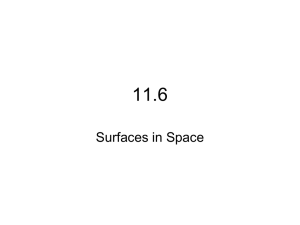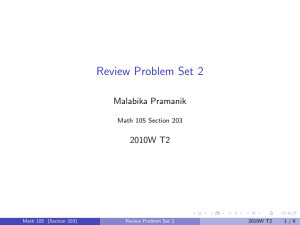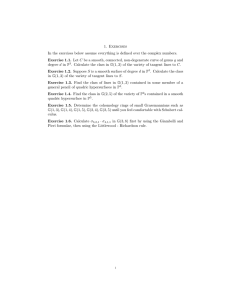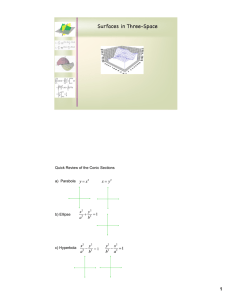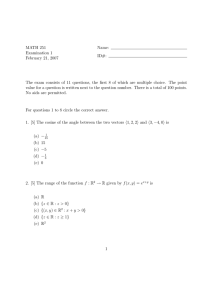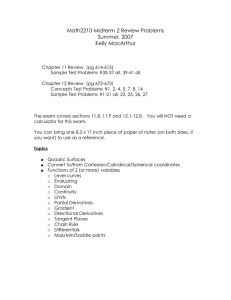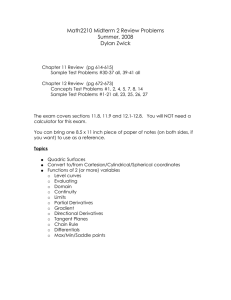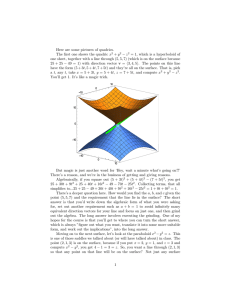Sketching graphs of quadric surfaces
advertisement
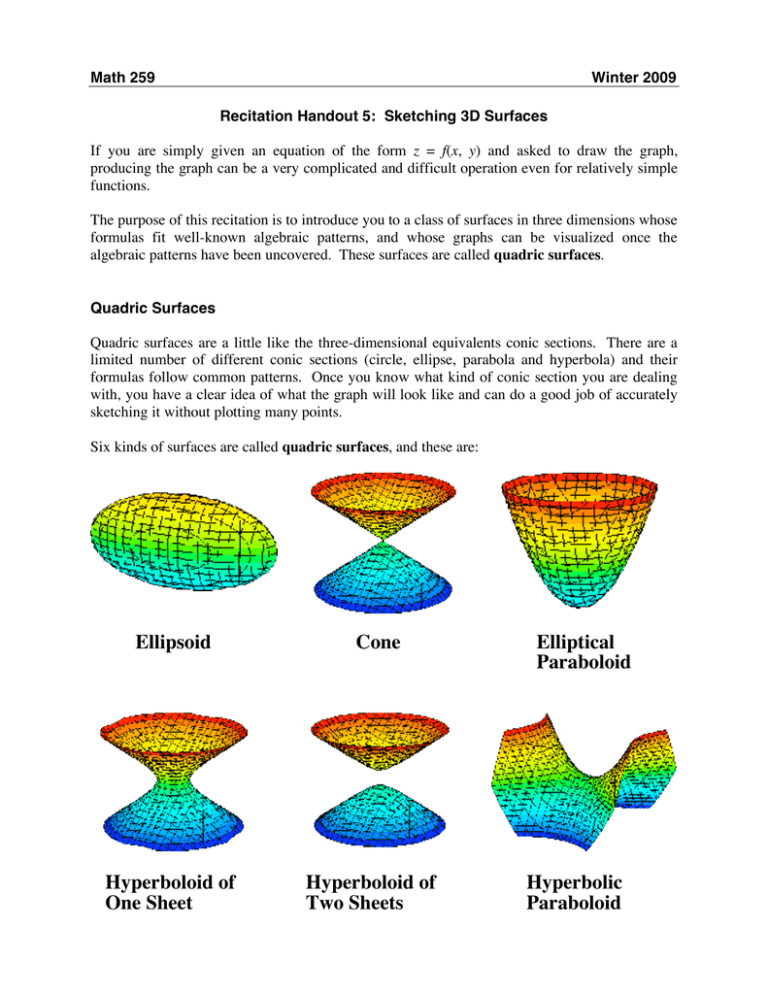
Math 259 Winter 2009 Recitation Handout 5: Sketching 3D Surfaces If you are simply given an equation of the form z = f(x, y) and asked to draw the graph, producing the graph can be a very complicated and difficult operation even for relatively simple functions. The purpose of this recitation is to introduce you to a class of surfaces in three dimensions whose formulas fit well-known algebraic patterns, and whose graphs can be visualized once the algebraic patterns have been uncovered. These surfaces are called quadric surfaces. Quadric Surfaces Quadric surfaces are a little like the three-dimensional equivalents conic sections. There are a limited number of different conic sections (circle, ellipse, parabola and hyperbola) and their formulas follow common patterns. Once you know what kind of conic section you are dealing with, you have a clear idea of what the graph will look like and can do a good job of accurately sketching it without plotting many points. Six kinds of surfaces are called quadric surfaces, and these are: Ellipsoid Hyperboloid of One Sheet Cone Hyperboloid of Two Sheets Elliptical Paraboloid Hyperbolic Paraboloid Sketching the Graph of a Quadric Surface The techniques that you have learned (i.e. contour plots) can be used to sketch accurate graphs of quadric surfaces in three dimensions. 1. Consider the quadric surface z = 4x2 + y2. Write down the equations for the contours that correspond to k = 1, 2, and 3. What kinds of curves are these? 2. Use the equations for the contours that you found above and the three-dimensional axes provided below to sketch a graph of the quadric surface z = 4x2 + y2. Of the six possibilities shown on the previous page, what sort of quadric surface is z = 4x2 + y2? z -2 -2 -1 -1 0 1 x 2 1 2 y Algebraic Formulas for Quadric Surfaces The downside to using a contour plot to draw the graph of a three dimensional surface is a lot like the downside of plotting points to draw a two dimensional graph – if you space your contours too far apart then you may miss important details on the graph. The graphs of quadric surfaces (like the graphs of conic sections) allow us to confidently draw an accurate graph with few contours because the algebraic structure of the quadric surface’s formula allows us to anticipate the appearance of the graph very accurately. The two typical formulas for quadric surfaces in three dimensions are: 2 2 2 A( x " x 0 ) + B( y " y 0 ) + C ( z " z0 ) + D = 0 and ! 2 2 A( x " x 0 ) + B ( y " y 0 ) + C ( z " z 0 ) = 0 , where A, B, C and D are constants and (x0, y0, z0) is a point that can sometimes be regarded as the “center” or “middle” of the surface. These equations are sometimes referred to as the standard forms for quadric surfaces1. Many equations!involving x, y and z can be transformed into one of the two equations given above, with the technique of Completing the Square being an important algebraic tool for doing this. Example Show that the following equation represents a quadric surface by putting it into one of the standard forms: x2 " y2 + 4y + z = 4 . Solution As z (rather than z2) appears!in the formula, we will try to make the given equation resemble the second standard equation. Subtraction 4 from both sides of the equation gives: x 2 " y 2 + 4 y " 4 + z = 0, so that: x 2 " ( y 2 " 4 y + 4) + z = 0 . ! Completing the square inside the parentheses gives: ! 2 x 2 " ( y " 2) + z = 0 , which follows the pattern of the second standard equation for a quadric surface. ! 1 There is a much more complicated general formula for the most general quadric form possible. If you go on to take a course in Linear Algebra you may learn how to use matrices and things called eigenvalues and eigenvectors to transform any quadric surface into one of the two standard forms given above. 3. Rearrange each of the following equations to one of the standard equations for a quadric surface. (a) z2 = 3x2 + 4y2 − 12. (b) z = x2 + y2 + 1. (c) x2 + y2 − 4z2 + 4x − 6y − 8z = 13. Classifying Quadric Surfaces The key to classifying conic sections (in polar coordinates) was the eccentricity. It is possible to calculate similar numbers that can be used to classify quadric surfaces but this is much more complicated than eccentricity. We will classify quadric surfaces by the structure of the equation for the surface. The formula for each quadric surface is summarized in the table given below (were we assume that a, b and c are all non-zero constants). Surface Graph Equation Comments Ellipsoid ( x " x0 ) a 2 2 + ( y " y0 ) b 2 2 + (z " z0 ) 2 =1 c2 ! Cone (z " z0 ) c 2 2 = ( x " x0 ) a 2 2 + ( y " y0 ) b2 ! Elliptic paraboloid 2 z " z0 ( x " x 0 ) ( y " y 0 ) = + c a2 b2 ! 2 2 Sphere is the case when a = b = c. The point (x0, y0, z0) is at the very center of the ellipsoid. The point (x0, y0, z0) is the point where the two parts of the cone meet. If either x or y appears as the subject of the equation, then the cone opens along that axis instead. One of the variables will be raised to the first power. This gives the axis that the paraboloid opens along. The case c > 0 is illustrated here. The point (x0, y0, z0) is the lowest point on the paraboloid. Hyperboloid of one sheet ( x " x0 ) a 2 2 + ( y " y0 ) b 2 2 " (z " z0 ) 2 c2 =1 ! Hyperboloid of two sheets " ( x " x0 ) a2 2 " ( y " y0 ) b2 2 + (z " z0 ) c2 ! Hyperbolic paraboloid 2 z " z0 ( x " x 0 ) ( y " y 0 ) = " c a2 b2 ! Example Determine the type of quadric surface that is defined by the equation: x2 " y2 + 4y + z = 4 . ! 2 2 =1 Only one of the terms will be subtracted. This gives the axis along which the hyperboloid opens. The point (x0, y0, z0) is at the center of the thinnest part of the surface Only one of the terms will be added. This gives the axis along which the hyperboloid opens. The point (x0, y0, z0) is at the halfway point between the sheets. This surface has a saddle shape like a Pringles potato chip. It is also possible for x to be subtracted and y added. The case c < 0 is illustrated here. Solution The given equation is equivalent to the following: 2 x 2 " ( y " 2) + z = 0 , which can be rearranged to give: 2 z = "x 2 + ( y " 2) . ! The equation from the table that this resembles is the equation for a hyperbolic paraboloid. A computer-generated graph of the surface confirms this classification. ! 4. Classify each of the following quadric surfaces. Use your results to match each equation with one of the graphs shown on the next page. (a) z2 = 3x2 + 4y2 − 12. (b) z = x2 + y2 + 1. (c) x2 + y2 − 4z2 + 4x − 6y − 8z = 13. Matching equation: Matching equation: Matching equation: Sketching a Quadric Surface In this part of the recitation, you will start with the formula for a quadric surface, classify it, find the coordinates of a few important points and then sketch an accurate graph in three dimensions. 5. Classify the type of quadric surface represented by the equation: 4x2 + 9y2 + 36z2 = 36. 6. Find the coordinates of all points where the quadric surface 4x2 + 9y2 + 36z2 = 36 crosses one of the coordinate axes. (Remember that there are three coordinate axes.) 7. Use the axes provided below to plot your answers to Question 6. Based on the classification that you made in Question 5, fill in the rest of the surface to create an accurate sketch of the quadric surface 4x2 + 9y2 + 36z2 = 36. z 4 3 2 -4 -4 -3 -3 1 -2 -2 -1 1 -1 -1 2 3 x 1 2 -2 4 3 4 -3 y 8. Use the axes provided below to sketch the graph of the quadric surface: y2 = x2 + z2. Hint: Read the comments in the table on classifying quadric surfaces carefully. z 4 3 2 -4 -4 -3 -3 1 -2 -2 -1 1 -1 -1 2 3 x 1 2 -2 4 3 4 -3 y
